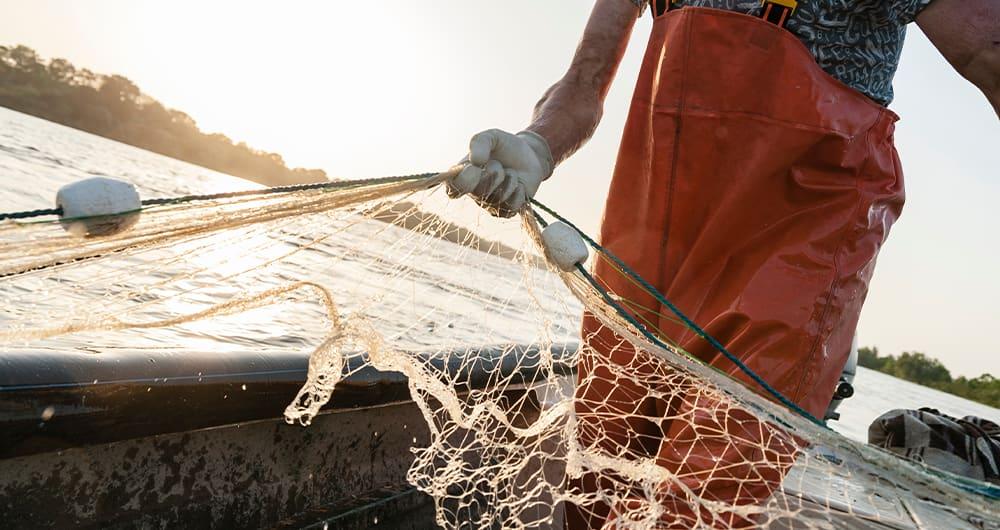
Satellite data has become a fundamental tool for understanding and monitoring our planet from a unique perspective. This data, collected by satellites in orbit around the Earth, provides a global and detailed view of various terrestrial, maritime and atmospheric phenomena that have applications in multiple sectors, such as environmental care or driving innovation in the energy sector.
In this article we will focus on a new sector: the field of fisheries, where satellite data have revolutionised the way fisheries are monitored and managed worldwide. We will review which fisheries satellite data are most commonly used to monitor fishing activity and look at possible uses, highlighting their relevance in detecting illegal activities.
The most popular fisheries-related satellite data: positioning data
Among the satellite data, we find a large amount ofpublic and open data , which are free and available in reusable formats, such as those coming from the European Copernicus programme. This data can be complemented with other data which, although also public, may have costs and restrictions on use or access. This is because obtaining and processing this data involves significant costs and requires purchasing from specialised suppliers such as ORBCOMM, exactEarth, Spire Maritime or Inmarsat. To this second type belong the data from the two most popular systems for obtaining fisheries data, namely:
- Automatic Identification System (AIS): transmits the location, speed and direction of vessels. It was created to improve maritime safety and prevent collisions between vessels, i.e. its aim was to prevent accidents by allowing vessels to communicate their position and obtain the location of other ships in real time. However, with the release of satellite data in the 2010s, academia and authorities realised that they could improve situational awareness by providing information about ships, including their identity, course, speed and other navigational data. AIS data went on to facilitate maritime traffic management, enabling coastal authorities and traffic centres to monitor and manage the movement of vessels in their waters. This technology has revolutionised maritime navigation, providing an additional layer of safety and efficiency in maritime operations. Data is available through websites such as MarineTraffic or VesselFinder, which offer basic tracking services for free, but require a subscription for advanced features..
- Vessel Monitoring System (VMS): designed specifically for fisheries monitoring, it provides position and movement data. It was created specifically for the monitoring and management of the modern fishing industry. Its development emerged about two decades ago as a response to the need for improved monitoring, control and surveillance of fishing activities. Access to VMS data varies according to jurisdiction and international agreements. The data are mainly used by government agencies, regional fisheries management organisations and surveillance authorities, who have restricted access and must comply with strict security and confidentiality regulations.The data are used mainly by government agencies, regional fisheries management organisations and surveillance authorities, who have restricted access and must comply with strict security and confidentiality regulations.. On the other hand, fishing companies also use VMS systems to manage their fleets and comply with local and international regulations.
Analysis of fisheries satellite data
Satellite data has proven to be particularly useful for fisheries observation, as it can provide both an overview of a marine area or fishing fleet, as well as the possibility of knowing the operational life of a single vessel. The following steps are usually followed:
- AIS and VMS data collection.
- Integration with other open or private sources. For example: ship registers, oceanographic data, delimitations of special economic zones or territorial waters.
- Application of machine learning algorithms to identify behavioural patterns and fishing manoeuvres.
- Visualisation of data on interactive maps.
- Generation of alerts on suspicious activity (for real-time monitoring).
Use cases of fisheries satellite data
Satellite fisheries data offer cost-effective options, especially for those with limited resources to patrol their waters to continuously monitor large expanses of ocean. Among other activities, these data make possible the development of systems that allow:
- Monitoring of compliance with fishing regulations, as satellites can track the position and movements of fishing vessels. This monitoring can be done with historical data, in order to perform an analysis of fishing activity patterns and trends. This supports long-term research and strategic analysis of the fisheries sector.
- The detection of illegal fishing, using both historical and real-time data. By analysing unusual movement patterns or the presence of vessels in restricted areas, possible illegal, unreported and unregulated (IUU) fishing activities can be identified. IUU fishing is worth up to US$23.5 billionper year in seafood products.
- The assessment of the fishing volume, with data on the carrying capacity of each vessel and the fish transhipments that take place both at sea and in port.
- The identification of areas of high fishing activity and the assessment of their impact on sensitive ecosystems.
A concrete example is work by the Overseas Development Institute (ODI), entitled "Turbid Water Fishing", which reveals how satellite data can identify vessels, determine their location, course and speed, and train algorithms, providing unprecedented insight into global fishing activities. The report is based on two sources: interviews with the heads of various private and public platforms dedicated to monitoring IUU fishing, as well as free and open resources such as Global Fishing Watch (GFW) - an organisation that is a collaboration between Oceana, SkyTruth and Google - which provides open data.
Challenges, ethical considerations and constraints in monitoring fishing activity
While these data offer great opportunities, it is important to note that they also have limitations. The study "Fishing for data: The role of private data platforms in addressing illegal, unreported and unregulated fishing and overfishing", mentions the problems of working with satellite data to combat illegal fishing, challenges that can be applied to fisheries monitoring in general:
- The lack of a unified universal fishing vessel register. There is a lack of a single database of fishing vessels, which makes it difficult to identify vessels and their owners or operators. Vessel information is scattered across multiple sources such as classification societies, national vessel registers and regional fisheries management organisations.
- Deficient algorithms. Algorithms used to identify fishing behaviour are sometimes unable to accurately identify fishing activity, making it difficult to identify illegal activities. For example, inferring the type of fishing gear used, target species or quantity caught from satellite data can be complex.
- Most of this data is not free and can be costly. The most commonly used data in this field, i.e. data from AIS and VMS systems, are of considerable cost.
- Incomplete satellite data. Automatic Identification Systems (AIS) are mandatory only for vessels over 300 gross tonnes, which leaves out many fishing vessels. In addition, vessels can turn off their AIS transmitters to avoid surveillance.
- The use of these tools for surveillance, monitoring and law enforcement carries risks, such as false positives and spurious correlations. In addition, over-reliance on these tools can divert enforcement efforts away from undetectable behaviour.
- Collaboration and coordination between various private initiatives, such as Global Fishing Watch, is not as smooth as it could be. If they joined forces, they could create a more powerful data platform, but it is difficult to incentivise such collaboration between competing organisations.
The future of satellite data in fisheries
The field of satellite data is in constant evolution, with new techniques for capture and analysis improving the accuracy and utility of the information obtained. Innovations in geospatial data capture include the use of drones, LiDAR (light detection and ranging) and high-resolution photogrammetry, which complement traditional satellite data. In the field of analytics, machine learning and artificial intelligence are playing a crucial role. For example, Global Fishing Watch uses machine learning algorithms to process millions of daily messages from more than 200,000 fishing vessels, allowing a global, real-time view of their activities.
The future of satellite data is promising, with technological advances offering improvements in the resolution, frequency, volume, quality and types of data that can be collected. The miniaturisation of satellites and the development of microsatellite constellations are improving access to space and the data that can be obtained from it.
In the context of fisheries, satellite data are expected to play an increasingly important role in the sustainable management of marine resources. Combining these data with other sources of information, such as in situ sensors and oceanographic models, will allow a more holistic understanding of marine ecosystems and the human activities that affect them.
Content prepared by Miren Gutiérrez, PhD and researcher at the University of Deusto, expert in data activism, data justice, data literacy and gender disinformation. The contents and views reflected in this publication are the sole responsibility of the author.


